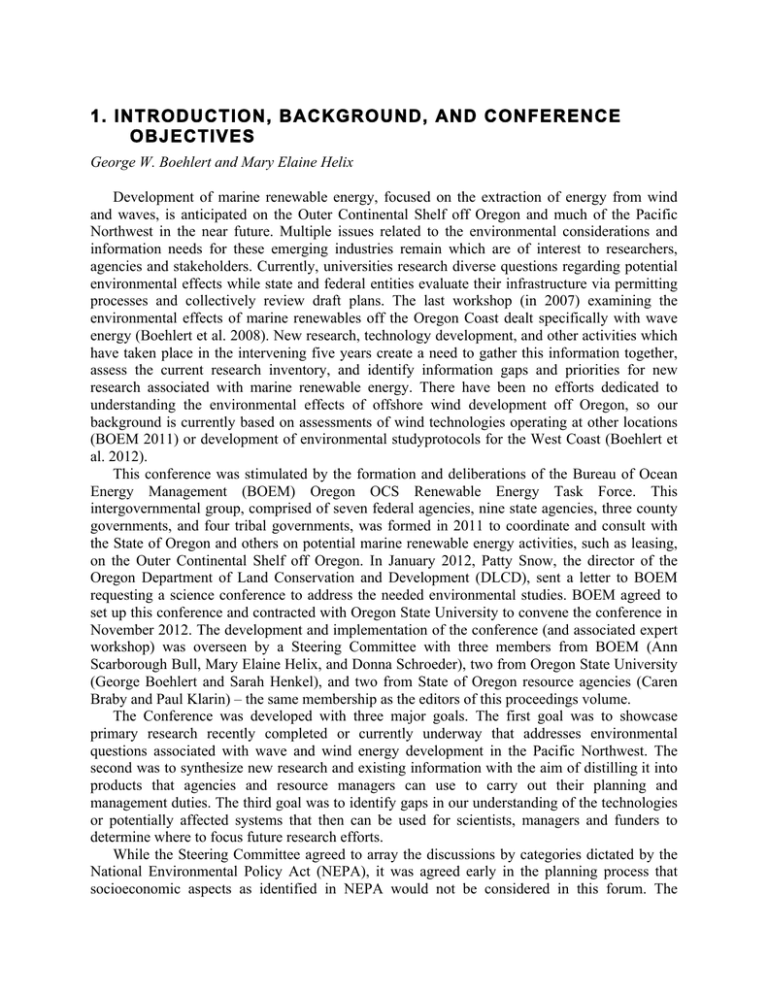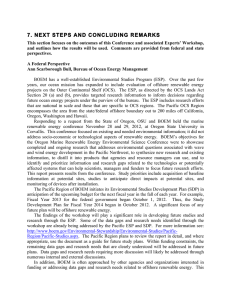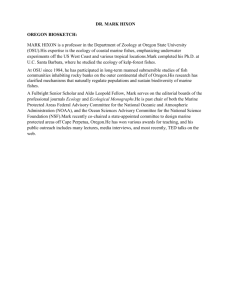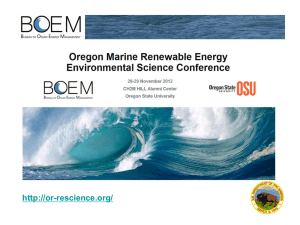1. INTRODUCTION, BACKGROUND, AND CONFERENCE OBJECTIVES
advertisement

1. INTRODUCTION, BACKGROUND, AND CONFERENCE OBJECTIVES George W. Boehlert and Mary Elaine Helix Development of marine renewable energy, focused on the extraction of energy from wind and waves, is anticipated on the Outer Continental Shelf off Oregon and much of the Pacific Northwest in the near future. Multiple issues related to the environmental considerations and information needs for these emerging industries remain which are of interest to researchers, agencies and stakeholders. Currently, universities research diverse questions regarding potential environmental effects while state and federal entities evaluate their infrastructure via permitting processes and collectively review draft plans. The last workshop (in 2007) examining the environmental effects of marine renewables off the Oregon Coast dealt specifically with wave energy (Boehlert et al. 2008). New research, technology development, and other activities which have taken place in the intervening five years create a need to gather this information together, assess the current research inventory, and identify information gaps and priorities for new research associated with marine renewable energy. There have been no efforts dedicated to understanding the environmental effects of offshore wind development off Oregon, so our background is currently based on assessments of wind technologies operating at other locations (BOEM 2011) or development of environmental studyprotocols for the West Coast (Boehlert et al. 2012). This conference was stimulated by the formation and deliberations of the Bureau of Ocean Energy Management (BOEM) Oregon OCS Renewable Energy Task Force. This intergovernmental group, comprised of seven federal agencies, nine state agencies, three county governments, and four tribal governments, was formed in 2011 to coordinate and consult with the State of Oregon and others on potential marine renewable energy activities, such as leasing, on the Outer Continental Shelf off Oregon. In January 2012, Patty Snow, the director of the Oregon Department of Land Conservation and Development (DLCD), sent a letter to BOEM requesting a science conference to address the needed environmental studies. BOEM agreed to set up this conference and contracted with Oregon State University to convene the conference in November 2012. The development and implementation of the conference (and associated expert workshop) was overseen by a Steering Committee with three members from BOEM (Ann Scarborough Bull, Mary Elaine Helix, and Donna Schroeder), two from Oregon State University (George Boehlert and Sarah Henkel), and two from State of Oregon resource agencies (Caren Braby and Paul Klarin) – the same membership as the editors of this proceedings volume. The Conference was developed with three major goals. The first goal was to showcase primary research recently completed or currently underway that addresses environmental questions associated with wave and wind energy development in the Pacific Northwest. The second was to synthesize new research and existing information with the aim of distilling it into products that agencies and resource managers can use to carry out their planning and management duties. The third goal was to identify gaps in our understanding of the technologies or potentially affected systems that then can be used for scientists, managers and funders to determine where to focus future research efforts. While the Steering Committee agreed to array the discussions by categories dictated by the National Environmental Policy Act (NEPA), it was agreed early in the planning process that socioeconomic aspects as identified in NEPA would not be considered in this forum. The Committee felt that focusing on environmental issues represented an attainable goal for the conference given the time and logistic constraints, and that the important issues represented in the socioeconomic realm could require a like number of specialists and could take an equal amount of time and effort. In light of the conference goals, the Steering Committee worked to develop a set of objectives and an agenda that would serve to accomplish these goals. Specifically, the Committee sought to: • assemble scientists with relevant expertise, key regulatory agency staff, and stakeholders in a workshop setting conducive to free information exchange; • identify existing and planned scientific research that addresses environmental concerns associated with the development of marine renewable energy; • identify data gaps related to evaluation of environmental effects and the scientific approaches needed to address these data gaps; • improve communication among all stakeholders in marine renewable energy development off Oregon; and • develop workshop products (website, proceedings document) that will make this information broadly available to all Oregon marine renewable energy stakeholders. Prior to the conference two websites were developed. The first, the conference and registration website (http://or-rescience.org), was designed to provide a broad overview of the conference, provide registration and contributed abstract submission, and link to the second website. The second website (http://hmsc.oregonstate.edu/rec) provided a higher level of detail, including the meeting agenda, abstracts for invited and contributed talks, and links to available background literature and previous conferences. The Steering Committee also commissioned a “gap analysis” prior to the workshop. The purpose of this analysis was to review existing studies and to develop a draft, first cut at identifying the gaps in needed environmental studies supporting wave and offshore wind development off the Oregon Coast. This draft was completed prior to the conference and distributed via the second web page as a “Conference Draft;” participants were alerted of its availability and encouraged to review it prior to the conference. The document has since been revised with input from conference attendees and is included in this document (Appendix B). The agenda was developed as a two day event (see Appendix A). The first day was designed as an open conference for to up 100 registrants; the intent was to encourage broad participation ranging from technical experts and agency scientists to the general public. It was divided into five sessions; the first three featured invited speakers selected by the Steering Committee to include i) presentations on how state and federal agencies utilize the environmental information collected, ii) review papers summarizing recently completed environmental studies on topics ranging from marine mammals and protected species through an experience paper on European research, and iii) presentation of featured environmental studies, providing information on the newest research, much of it in progress at the present time. Finally, a summary of the gap analysis paper was presented to set the stage for the breakout groups the following day. The final session was a reception and poster session of contributed papers, where other relevant research studies could be highlighted by conference participants. The second day was an “Experts’ Workshop” where invited scientists with technical expertise on marine ecosystems and environmental effects of marine renewable energy met to review the gap analysis and provide advice on priority studies. The Steering Committee selected participants based on the goal of assembling a balanced group that included scientists with expertise needed to address key environmental considerations and state and federal agency administrators and scientists responsible for the appropriate programs. A focal point of the workshop was a set of three facilitated breakout sessions with specific objectives. These sessions track with the Federal/State agency energy facility review process, providing feedback to directly inform their review. The three breakout sessions topics were: i) baseline studies, ii) impact and short-term studies, and iii) monitoring and long-term studies. The instructions to the breakout groups (Appendix C) were very specific, asking participants to develop priorities based on a matrix of NEPA criteria. This approach provided a clear context of applicability to agency requirements, requesting that participants develop priorities that could be mapped to the categories that agencies must address as projects are proposed and reviewed in the OCS region off Oregon. The breakout groups also addressed a variety of key questions related to the conference’s scientific objectives. This report is the output of the Conference and Experts’ Workshop described above. It is organized in a manner similar to that of the agenda, with extended abstracts of invited papers, the gap analysis paper, and the breakout group reports in the body of the report, and appendices consisting of the conference agenda, instructions to the breakout groups, contributed abstracts, and a list of the conference participants. We have also developed a permanent electronic archive at URL HERE that includes this report as well as a background document to the gap analysis and PDF versions of the electronic presentations from the first day of the conference. Appropriate links are contained in the electronic version of this report. Literature Cited Boehlert, G.W, G.R. McMurray, and C.E. Tortorici (eds.). 2008. Ecological effects of wave energy in the Pacific Northwest. U.S. Dept. Commerce, NOAA Technical Memorandum NMFS-F/SPO-92, 174 p. Boehlert, G., R. Chwaszczewski, A. Copping, K. Fresh, T. Hampton, S. Henkel, J. Klure, S. Kramer and G. McMurray (eds.). 2012. West Coast Environmental Protocols Framework: Baseline and Monitoring Studies. OCS Study BOEM 2012-013, 316 p. BOEM (Bureau of Ocean Energy Management). 2011. Environmental Monitoring and Baseline Studies: Overview, Summary and Needs. Atlantic Wind Energy Workshop, July 12-14, 2011, Herndon, VA. Bureau of Ocean Energy Management.





